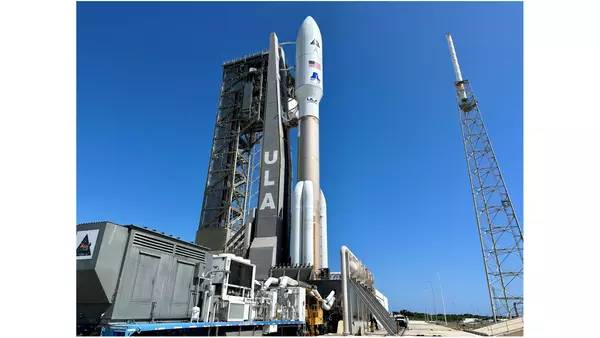In order to monitor the activity of possible adversary spacecraft in the high orbit favored by spy satellites, communications stations, and other high-priority U.S. assets, a United Launch Alliance Atlas 5 rocket sent three National Reconnaissance Office satellites into space on Sunday.
“Silent Barker” is the name given to the NROL-107 payload, which consists of an unspecified number of satellites designed to operate in a geosynchronous orbit 22,300 miles above the equator.
According to NRO Director Chris Scolese, the goal of the mission is to place a satellite in geosynchronous orbit and then observe that orbital regime to learn more about daily events.
In addition to monitoring typical satellite movements, “we also want to know if there is something going on that is unexpected, or shouldn’t be going on that could potentially represent a threat to a high-value asset, either ours, or one of our allies,” Scolese said.
“So that’s the idea behind it. In that orbital regime, the geosynchronous orbit, it primarily serves as a watchdog.
At 8:47 a.m. ET, the Russian-built RD-180 first stage engine and five GEM-63 strap-on solid-fuel boosters fired up and propelled the Atlas 5 off of pad 41 at the Cape Canaveral Space Force Station.
As ULA continues its ongoing transition to the company’s new Vulcan rocket, the launch, which was postponed from Aug. 29 by Hurricane Idalia and subsequently by a technical issue, marks the 18th and last Atlas 5 NRO flight.
The NRO disclosed the overall objective of the NROL-107 payload, but kept secret information regarding the Silent Barker satellites’ ascent and orbital settings. Because no additional information on the flight was immediately available, ULA halted its launch commentary as the rocket’s first stage was finishing its “burn.”
But it is commonly known what a geosynchronous orbit is. At that altitude, satellites orbit the Earth once every 24 hours, rotating in unison and appearing immobile in the sky. This enables hemispheric coverage for satellites that are used for electronic espionage, such as weather satellites, commercial and military data relay stations, and spy satellites.
Military reconnaissance and communications satellites would be attractive targets for anti-satellite weapons in a major conflict, as well as targets for close-range inspection by enemy spacecraft, before that. Both China and Russia are rumored to possess satellites with the capability to control, rendezvous with, inspect, and possibly interfere with spacecraft operated by the United States and its allies.
However, in the case of Silent Barker, officials claimed they wanted potential enemies to be aware of America’s capacity to monitor any such threats to the so-called “geo belt,” which is challenging to monitor from Earth’s surface due to the distances involved and the whims of weather and lighting.
According to Lt. Gen. Michael Guetlein, chief of Space Systems Command for the U.S. Space Force, “the ability for the adversary to know what we can and cannot see is a huge element of deterrence.” “As a result, we genuinely want our rivals to be aware that we have eyes in geo and are aware of what is going.
“Not only will we keep watch over geopolitical events and be able to detect them, but we’ll also have the signs and warnings to let us know when anything unusual is happening. And that effectively discourages behavior.
The first of at least two missions resembling Silent Barker was launched on Sunday. It’s anticipated that the initiative will be completely functioning by 2026.
In order to help us make decisions about what to do or not do in terms of maneuver or awareness, Silent Barker will provide that hint and warning, according to Scolese. It will substantially improve our capacity to choose future courses of action and will greatly raise our understanding of what we will be able to do.





